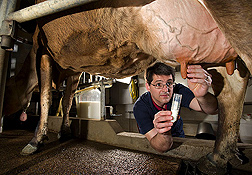This page has been archived and is being provided for reference purposes only. The page is no longer being updated, and therefore, links on the page may be invalid.
Read the magazine storyto find out more. |
|
|
Profiling Protective Proteins in Dairy Cows
By Ann PerryAugust 13 , 2008
Agricultural Research Service (ARS) molecular biologist John Lippolis is delving into the dynamics of the dairy cow immune system. His work is resulting in the first close-up look at how immune system proteins help protect the cows, and how bacterial proteins fight back.
Lippolis works at the ARS Periparturient Diseases of Cattle Research Unit, part of the National Animal Disease Center in Ames, Iowa. He is using proteomics--the identification of the proteins that make up a cell--to identify and study neutrophils, the white blood cells that are a key part of the immune system.
When dairy cows develop mastitis, a bacterial infection that costs dairy producers some $2 billion every year, neutrophils are an essential part of the immune response. Lippolis identified proteins in bovine neutrophils and tracked how they change during infection.
Lippolis identified hundreds of neutrophil proteins. Nearly 35 percent were associated with basic cellular metabolic pathways, including most of the proteins involved in the production of cellular energy. Another 30 percent were involved in immune functions or in cell structure and mobility.
Lippolis then compared these newly identified neutrophil proteins in pregnant cows with those in cows that were in an immunosuppressive interlude after calving. Compared to the pregnant cows, he observed changes in the concentration of 40 proteins in the immunosuppressed cows.
Lippolis also compared neutrophils from periparturient cows--animals that had recently given birth and were in an immunosuppressive interlude--with neutrophils from cows that had been given the steroid dexamethasone to artificially suppress immune function. Although he found some similar changes in protein expression in both groups, there were also some significant differences between them.
All of these findings could guide Lippolis and other researchers in their search for ways to bolster bovine immune systems at the cellular level.
Read more about the research in the August 2008 issue of Agricultural Research magazine.
ARS is a scientific research agency of the U.S. Department of Agriculture.

